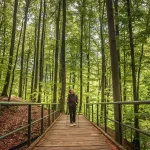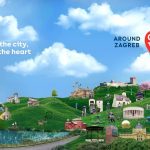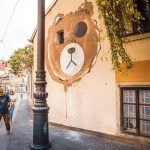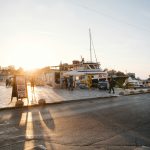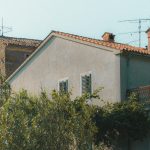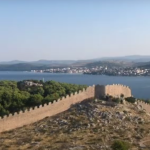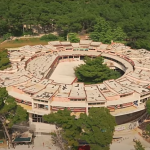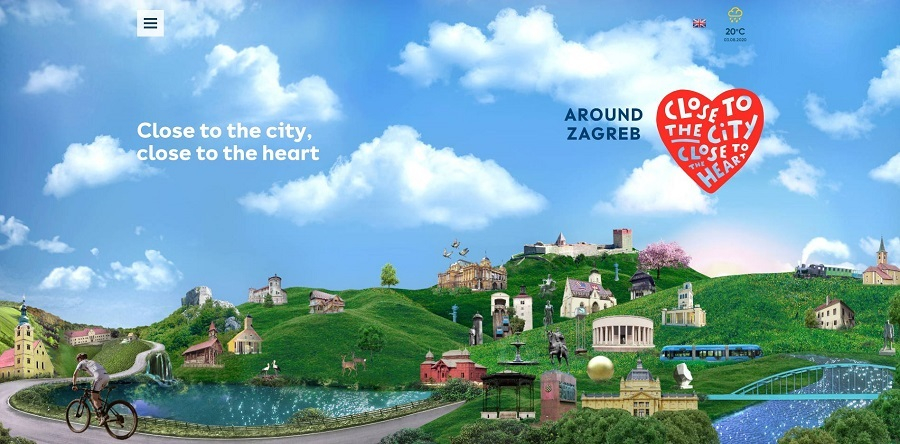
August 3, 2020 – The new Around Zagreb website is proving a hit, as well as leading the way with a new integrated tourism approach.
The stereotype of Croatian tourism is that of sun, sea and beach. With 1,777 km of glorious Adriatic coastline and more than 1,000 islands to choose from, that is completely understandable. And yet, in the last decade, tourism in Croatia has diversified a lot, with destinations away from the coast emerging as credible holiday alternatives to two weeks sitting on the beach.
And the destination which has made the most progress in the last decade – at least in my opinion – is far away from the coast.
The capital city Zagreb.
When I first moved here back in 2002, a visit to the capital left me cold. The food was one-dimensional and there did not seem to be that much to do. And then something changed, and with that small change came more change, and then the floodgates of change came. Suddenly, Zagreb had become a very cool city, so much so that Lonely Planet even named it the Best Destination in Europe in 2017.
EU entry in 2013 helped to bring a new international aspect to Zagreb, of course, but it was innovations elsewhere that really drove the change. Innovative museums such as the Museum of Broken Relationships, the Museum of Illusions, the Museum of Torture and more recently, the Museum of Hangovers, gave Zagreb an alternative cultural side of things, its street art flourished, there was an explosion of international dining options, wine bars and a vibrant craft beer scene to add to the laganini coffee lifestyle for which Croatia is rightly famous.
It is also the only destination (again, in my opinion) that has successfully managed to extend the season in Croatia. In just a few years, Advent in Zagreb went from a nothing event to being voted the Best Christmas Market in Europe three years in a row. Its marketing adorns the trams and buses of major European cities, and thousands of foreign visitors pour into Zagreb each December to enjoy the seasonal festivities.
The corona crisis put a screeching halt to tourism worldwide, with many destinations more or less closed down. As tourism reemerged, albeit very slowly, once global lockdowns were eased, it was clear that a new approach to tourism to reflect the new normal was essential.
Which is one of the reasons I was so impressed with the new joint Around Zagreb initiative from the tourist boards of the City of Zagreb and Zagreb County. As I wrote a few weeks ago, the Around Zagreb site brings together all the outdoor activities and socially distanced opportunities available, both in the city itself, but also in the immediate vicinity of Zagreb County. You can check out the website here.
A simple idea, but one which completely changes the perspective of the destination. Something I reflected on last week during my visit to Dubrovnik. The Pearl of the Adriatic is a stunning city attraction for a couple of days, but if you market it as Around Dubrovnik, suddenly the content multiplies several times in an instant.
Suddenly, Zagreb was no longer a city, but a city with lungs and plenty of wide-open spaces offering a wealth of fun things to see and do which perhaps you would not expect to find on a visit to a capital city. Here are five that caught my eye from the Around Zagreb website, which I should add is one of the most informative and well-written official tourism websites I have seen in 10 years of following the sector:
Truffle Hunting
Truffle hunting near Zagreb? You won’t find too many local who know about this. One of the great building blocks of the Istrian gourmet scene, you don’t have to travel that far from the Croatian capital to take part in this very unique pastime to go in search of one of Croatia’s most sought-after Croatian delicacies:
In Zagreb, mushroom hunting is a respected and popular pastime activity, so the forests around the city can be teeming with adept foragers after rain, both hobbyists and serious hunters. During the season, farmers’ markets in Zagreb are full of fresh forest mushrooms, most often boletus. Yet, few people know that a real edible treasure is hidden underground on the outskirts of Zagreb – black truffles. These rare wild mushrooms grow in dense and wet forests, mostly oak and beech, common on the slopes of Medvednica Mountain. Knowledge and experience is required for truffle hunting, and since they are hidden beneath the ground, it is impossible to find them without specially trained dogs. The aromatic truffles are the tastiest when they are freshly shaved, and they are also often used to spice up cheese, honey, chocolate or honey brandy. In Zagreb you can enjoy the unique experience of guided truffle hunt, combining a forest adventure with the pleasure of tasting this exclusive treat in one of the selected restaurants in the city. Another proof that the folks of Zagreb genuinely appreciate mushrooms is the Mushroom Museum just off the main square, exhibiting more than 1500 species of freeze dried mushrooms.
Wine-tasting in the ‘Champagne’ capital of Croatia
So too with wine. Istria, Dalmatia and Slavonia are famous wine regions, but did you know that the city of Zagreb has its very own wine road? Or that a short drive will take you to one of the country’s most diverse wine regions, famed for the best sparkling wines in all Croatia?
The Plešivica Wine Road has been open since 2001, bringing together around forty winemakers with diverse touristic attractions. There you can sample native and domesticated varieties such as Blauer Portugieser, Plavec žuti, Rotgipfler and Šipelj, along with world-renowned varieties such as Chardonnay, Riesling, Sauvignon, Gewürz and Pinot noir, blanc and gris. Wines from Plešivica win awards year after year in Croatia and all around the world.
The tourist offer of the Plešivica Wine Road can be divided into three categories: all winemakers offer wine tasting in their wine cellars, some offer homemade food along with wine tasting, and winemakers from the last category offer, together with wine and food, accommodation in strikingly furnished accommodation establishments overlooking the breathtaking “amphitheater” of Plešivica.
A round of golf, perhaps?
Golf might not be the first thing you think about when you plan a trip to Zagreb, but it is comforting for golf enthusiasts to know that there is a full 18-hole course just outside the city if they want to practice their swing one afternoon while visiting. If you come at the right time of year, you can even do a round wearing a kilt and drinking whiskey with some local lovers of all things Scottish.
The history of golf in this area is not so recent. Back in 1929, a group of enthusiasts in Zagreb dreamt about a golf course in the city, and the first practice ground was really opened in Maksimir Park, in 1931. Golf in Zagreb then vanished for a while, until the early 2000s, when a much more appropriate location near Blato, in the suburbs, opened its doors. In the spacious green field on the south bank of the Sava River, only a 15-minute ride from the centre of Zagreb, you can find Riverside Golf Zagreb. It includes a 9-hole executive course and an 18-hole championship course, as well as a large driving range with 40 bays and a chipping green, with options to practice in bad weather or at night. The attractive club house with a large terrace is the place for socialising, and there is also a restaurant at hand. Even if you don’t play and have no strong interest in golf, Riverside Golf Zagreb is a pleasant place for a short break in the outdoors, in the peaceful surroundings untypical for a big city.
The healing powers of Naftalan
Croatia has long been famous for its wellness and health tourism. Indeed, the founding of the Hvar Health Society in 1868 is credited as the birth of organised tourism in Europe.
The region surrounding Zagreb has a number of excellent wellness opportunities, including one with something that can only be found in one other place outside Croatia:
Thanks to the Pannonian Sea that used to cover parts of central Croatia, the area below Ivanić-Grad hides a true treasure: naftalan oil. Naftalan is made by distilling naftalan oil. Naftalan is petroleum mineral oil made by sedimentation of dead microorganisms’ remains, and it is valuable due to its numerous healing properties. Not only is it valuable, but it is also an extremely rare natural phenomenon. It is so rare that it can only be found in two places in the world: in Azerbaijan and in Croatia. Naftalan was first found next to Ivanić-Grad in the 1960s, and in 1989, the Naftalan Special hospital for medical rehabilitation was founded. The Hospital is the only place of that kind in Europe.
Despite the fact that the commercial use of naftalan for medical purposes is a relatively new phenomenon, people have been aware of its beneficial properties for centuries. The first notes on naftalan were written by world traveler Marco Polo, but the notes referred to the sources in Azerbaijan, on the Silk Road. In Ivanić, it is successfully used to treat rheumatic diseases, spinal joint diseases, and skin diseases. The naftalan oil bath is a unique experience that has beneficial effects on your skin and body. Other than using naftalan for oil baths, experts have created special, naftalan-based cosmetic products: lotions, oils and shampoos. The products are used to complement treatments done in the Hospital, but are also available on the market.
People come to Naftalan for the powerful, black-brown oil treatment, and for the benefits of healing thermal water. Thermal water is also a remainder of the Pannonian Sea, and it is sourced 1300 meters below the ground. The salty oil water that is rich in minerals can prevent and treat numerous health issues, and is generally beneficial to the body. Regardless of its focus on a broad spectrum of health treatments, Naftalan is also a well-known wellness and spa destination. Naftalan offers accomodation with 137 beds, 26 of which come with top-standard service. A sports park near the Hospital complements everything Naftalan has to offer, and the Moslavina region, with its developed rural and wine tourism, has all merits needed to amaze the visitors who want to explore the region.
Inside the secrets of a 16th-century mine
One of the feelings one has browsing the Around Zagreb website is just how much wonderful nature there is surrounding the city, as well as its many historic buildings. And sometimes you can combine the two with a little heritage and history of yesteryear in a family outing of discovery to the 16th century Zrinski Mine, for example:
In the past, Medvednica Mountain was an important treasure of natural resources for the people of Zagreb, so they also dug deep in it, searching for precious metals. After the discovery of galena ore, a source of silver, a mine was opened in the 16th century. The hardworking miners dug and dug painstakingly, but the mine was simply not productive enough, and closed down the following century. After a few hundred years of silence, these dark and cold tunnels are now accessible to curious visitors in search of a special experience.
Five experiences from many. If you are contemplating a trip to Zagreb, I heartily recommend the Around Zagreb website for trip ideas and things that you had perhaps not thought of or known about. And the 3-day itinerary selections for family, art, nature, foodies, history buffs and romantics, are excellent.

